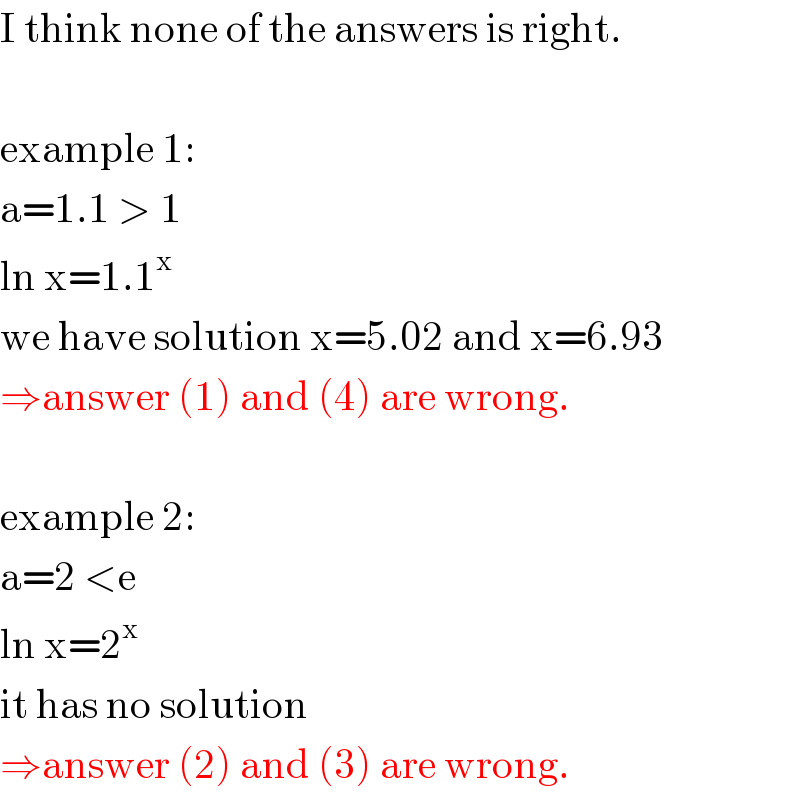
Question Number 15184 by Tinkutara last updated on 08/Jun/17
![If y = ln x and y = a^x have a solution then find the range of a. (1) (0, 1) (2) ((1/e), e) (3) (1, e) (4) (0, 1]](Q15184.png)
$$\mathrm{If}\:{y}\:=\:\mathrm{ln}\:{x}\:\mathrm{and}\:{y}\:=\:{a}^{{x}} \:\mathrm{have}\:\mathrm{a}\:\mathrm{solution} \\ $$$$\mathrm{then}\:\mathrm{find}\:\mathrm{the}\:\mathrm{range}\:\mathrm{of}\:{a}. \\ $$$$\left(\mathrm{1}\right)\:\left(\mathrm{0},\:\mathrm{1}\right) \\ $$$$\left(\mathrm{2}\right)\:\left(\frac{\mathrm{1}}{{e}},\:{e}\right) \\ $$$$\left(\mathrm{3}\right)\:\left(\mathrm{1},\:{e}\right) \\ $$$$\left(\mathrm{4}\right)\:\left(\mathrm{0},\:\mathrm{1}\right] \\ $$
Commented by mrW1 last updated on 08/Jun/17

$$\mathrm{I}\:\mathrm{think}\:\mathrm{none}\:\mathrm{of}\:\mathrm{the}\:\mathrm{answers}\:\mathrm{is}\:\mathrm{right}. \\ $$$$ \\ $$$$\mathrm{example}\:\mathrm{1}: \\ $$$$\mathrm{a}=\mathrm{1}.\mathrm{1}\:>\:\mathrm{1} \\ $$$$\mathrm{ln}\:\mathrm{x}=\mathrm{1}.\mathrm{1}^{\mathrm{x}} \\ $$$$\mathrm{we}\:\mathrm{have}\:\mathrm{solution}\:\mathrm{x}=\mathrm{5}.\mathrm{02}\:\mathrm{and}\:\mathrm{x}=\mathrm{6}.\mathrm{93} \\ $$$$\Rightarrow\mathrm{answer}\:\left(\mathrm{1}\right)\:\mathrm{and}\:\left(\mathrm{4}\right)\:\mathrm{are}\:\mathrm{wrong}. \\ $$$$ \\ $$$$\mathrm{example}\:\mathrm{2}: \\ $$$$\mathrm{a}=\mathrm{2}\:<\mathrm{e} \\ $$$$\mathrm{ln}\:\mathrm{x}=\mathrm{2}^{\mathrm{x}} \\ $$$$\mathrm{it}\:\mathrm{has}\:\mathrm{no}\:\mathrm{solution} \\ $$$$\Rightarrow\mathrm{answer}\:\left(\mathrm{2}\right)\:\mathrm{and}\:\left(\mathrm{3}\right)\:\mathrm{are}\:\mathrm{wrong}. \\ $$
Commented by Tinkutara last updated on 08/Jun/17

$$\mathrm{But}\:\mathrm{answer}\:\mathrm{is}\:\left(\mathrm{4}\right).\:\mathrm{When}\:\mathrm{seen}\:\mathrm{from} \\ $$$$\mathrm{graphs},\:\mathrm{they}\:\mathrm{actually}\:\mathrm{intersect}.\:\mathrm{But} \\ $$$$\mathrm{how}\:\mathrm{to}\:\mathrm{find}\:\mathrm{the}\:\mathrm{solution}\:\mathrm{algebrically}, \\ $$$$\mathrm{I}\:\mathrm{don}'\mathrm{t}\:\mathrm{know}. \\ $$
Commented by mrW1 last updated on 08/Jun/17
![the max. value of a is not to calculate algebrically.it is about 1.10215. so the range of a should be (0, 1.10215]](Q15259.png)
$$\mathrm{the}\:\mathrm{max}.\:\mathrm{value}\:\mathrm{of}\:\mathrm{a}\:\mathrm{is}\:\mathrm{not}\:\mathrm{to}\:\mathrm{calculate} \\ $$$$\mathrm{algebrically}.\mathrm{it}\:\mathrm{is}\:\mathrm{about}\:\mathrm{1}.\mathrm{10215}.\:\mathrm{so} \\ $$$$\mathrm{the}\:\mathrm{range}\:\mathrm{of}\:\mathrm{a}\:\mathrm{should}\:\mathrm{be} \\ $$$$\left(\mathrm{0},\:\mathrm{1}.\mathrm{10215}\right] \\ $$
Commented by Tinkutara last updated on 08/Jun/17

$$\mathrm{Thanks}\:\mathrm{Sir}! \\ $$
